2024 Subaru Crosstrek Wilderness First Drive Review: Practical, Capable Overlander
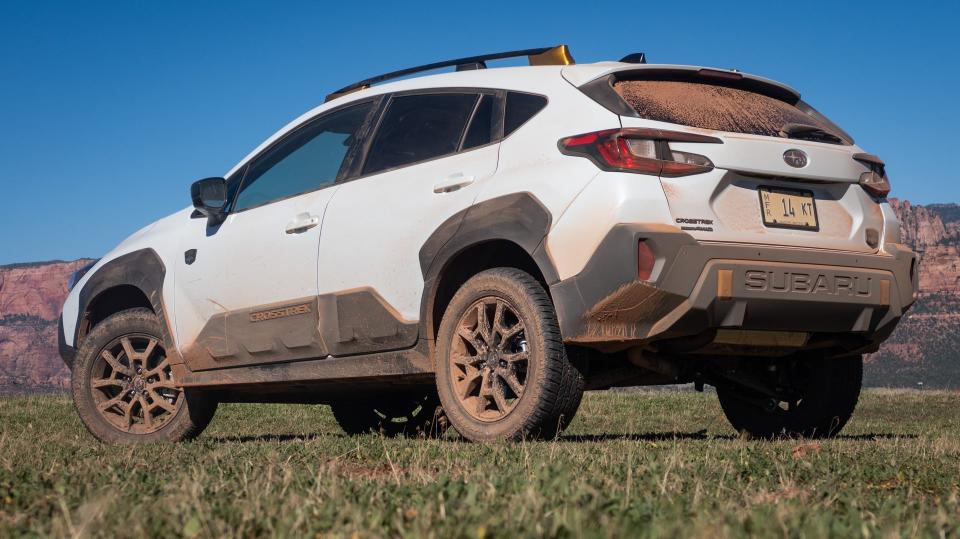
There’s no single best adventure vehicle. A dialed-in Land Cruiser can cross continents, but something like my old ’70s Scout makes every drive feel like an epic expedition. The 2024 Subaru Crosstrek Wilderness kind of splits the difference, focusing on an angle that’s underrated in the off-road scene: Practicality. Cool-looking, versatile, and not outrageously expensive, this compact crossover is pretty neat.
Subarus have long been popular among outdoorsy types for their utility and rough-condition readiness. The brand’s Wilderness trim leans into that, adding some clearance and cladding for the look and some functional features to back it up.
2024 Subaru Crosstrek Wilderness Specs | |
|---|---|
The Basics
The Subaru Crosstrek, in its third generation for 2024, is a small wagon, chunky hatchback, or compact crossover depending on who describes it. It’s Subie’s smallest five-door and generally a good-looking get-around car for people with moderate cargo needs and modest budgets who are also not in a rush (there’s no turbo option).
This new Wilderness spec has unique suspension lifting the vehicle 0.6 inches higher than other Crosstreks, along with a few other features to enhance its rough-terrain driving capabilities.
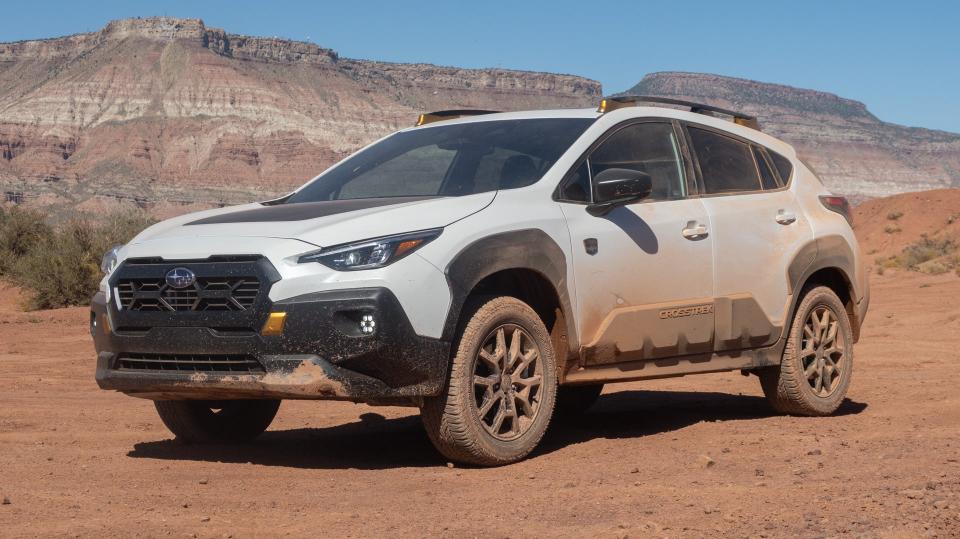
Subaru has already done a Wilderness version of the Outback and Forester which got largely the same treatment: Small suspension lift, meaty tires, a few extra supporting mods, and most importantly, tough-looking bumpers and cool gold accents.
The gold trim on the emblems, tow hook covers, and roof racks is now Subaru’s signature “off-road variant” aesthetic cue. It’s unique and great-looking, though not a nod to Subaru’s rally history (which often had cars sporting gold wheels). The anodized gold was inspired by the finish on high-end outdoor equipment, like this carabiner:

Exterior and Interior Design
The standard Crosstrek is just distinctive enough to have some personality while remaining largely inoffensive. A few pieces of plastic cladding do most of the work to make it stand out, but it’s totally decent-looking among normie cars in showrooms today.
The Wilderness variant manages to look a lot more interesting with minimal substantial changes. The addition of a more black-colored body cladding along with a mean stance on knobby tires gives the car just the right amount of “let’s do this” energy that makes it fun to look at without inducing eye rolls.
I think it kind of looks like a near-future space pod. Subaru was clearly going for a top-shelf-at-REI image with this car but I think it’s kind of giving some NASA punk, especially in white on Utah’s Martian-looking landscape.
Inside, Wilderness touches are once again minimal but meaningful. Some more gold accenting adds some pop and Subaru’s non-leather StarTex water-repellent upholstery feels great while bringing the outdoorsy look inside. The “Wilderness” emblem itself is a little goofy to me, but the all-weather floormats feel good.








The interior in general isn’t expansive but there’s room for four and their duffle bags. The design of the dashboard is excellent. Some bold shapes carry over from the doors and across the console while two friendly, familiar analog gauges (tach and speedometer) keep you company ahead of the steering wheel.
As in other modern Subarus, the infotainment screen is vertically oriented, making it more phone-like than the widescreen ones. It’s tucked nicely into the dash.
Crosstrek Wilderness Off-Road Features
There are a handful of worthwhile upgrades the Wilderness gets over the standard Crosstrek, which I’ll run through and contextualize.
A modest 0.6-inch lift is achieved with longer springs and dampers. Suspension travel is the same as the base car, ground clearance now measures 9.3 inches, which is a lot. More than some Land Rover Defenders. More importantly, I felt the Wilderness’ suspension did a nice job of providing consistent response on the road while being remarkably compliant over deep corrugations and rocks, but we’ll talk about that soon.
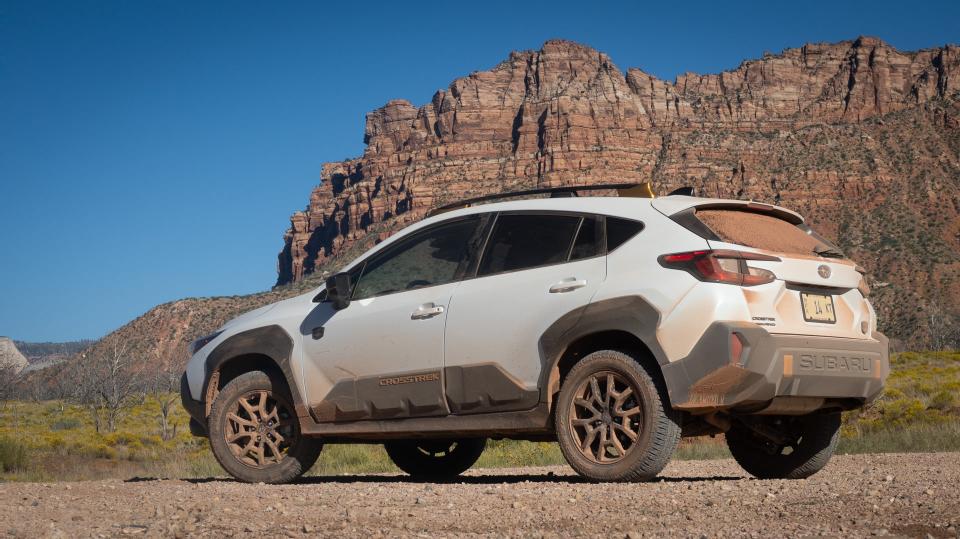
Also under the car is an engine skid plate (always nice to have factory-designed armor), a supposedly more robust rear differential (Subaru R167 instead of R152, for the nerds), and an extra pressure sensor in the continuously variable transmission. Subaru’s people explained that that sensor would allow the CVT to react more quickly and appropriately in low-traction or sticky conditions. Subaru’s X-Mode traction control setting also helps the car keep moving through rough stuff, extrapolating for conditions and applying power as best as it can.
Speaking of the trans, Wilderness gets a transmission cooler that the standard C’trek doesn’t as well as a higher-output radiator fan for better engine cooling.



The tires, however, are probably what’s responsible for the most appreciable improvement in capability over other Subarus. The Yokohama Geolandar all-terrains that we gave an honorable mention as one of the best SUV tires available felt good to me. We didn’t really put their puncture resistance to the test, but I felt like I had fine traction in soft sand and through rock gardens. Noise on the road was minimal.
Interestingly, the diameter of this tire (27.6 inches) is actually slightly smaller than the standard Crosstrek’s. That was probably done simply due to tire availability, though the smaller size should also slightly mitigate the performance penalty brought by the added weight of the chunky all-terrain treads.
Otherwise, the car also has a couple of little features that are genuinely useful. In the cargo area, there are two huge cupholders, for tailgate-party or post-exercise recuperation situations. There’s also a switched light on the inside of the cargo hatch for nighttime cargo loading. And my personal favorite—the rear door jambs are designed in such a way that there’s an easy place to put your foot when you’re trying to access something on the roof.

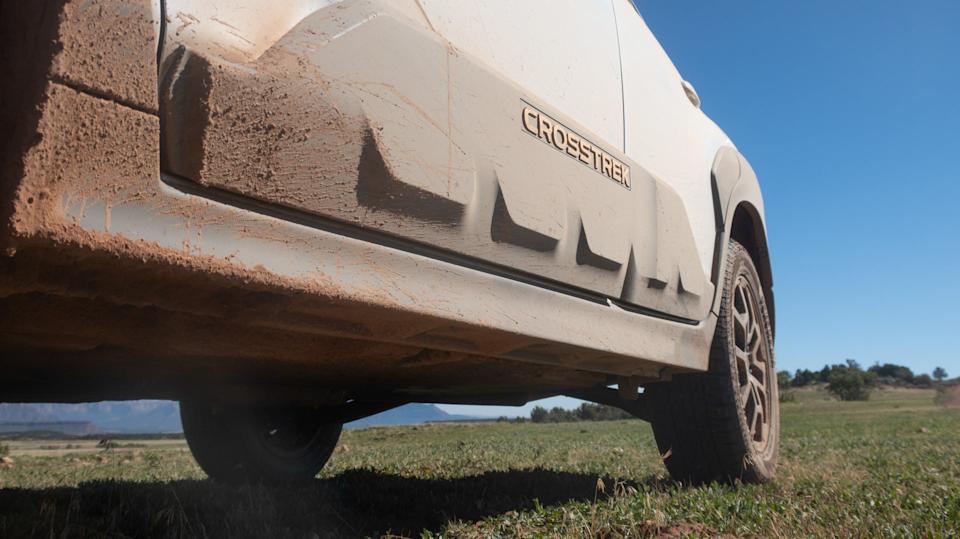



The low roofline is itself a solid reason to go for a Crosstrek instead of a taller SUV—it’s much easier to get stuff off the roof of this thing than my Montero. I’m six-foot and I never actually put anything on my truck’s roof rack because it’s too annoying to reach. But with this car, even a much shorter person would be able to access a bike, boat, or ski box that might be up there.
Realistic Off-Road Capability
Every review of this car is going to declare that the Crosstrek Wilderness exhibits “all the off-road capability you really need” or something to that effect, so I’ll do my best to be more specific.
Fire roads, unmaintained roads, and those tiny, wild-track roads you need an old map to find—in conditions like that, the Crosstrek Wilderness would shine. With its clearance and short overhangs, I think it would even surprise some people in a rock-crawl situation. I could see it completing the easier Moab slickrock trails in the hands of a capable and patient driver.



A lot of the west’s drivable public land would be traversable with a Crosstrek Wilderness, too. The steepest sections of popular wide-open spots like Johnson Valley in California or Cinder Hills in Arizona would stump this car, but you could get around a lot of great off-highway vehicle areas in this thing no problem.
Its biggest challenges would be long climbs, serious rock-crawl conditions, and anything thick and soupy like deep sand or mud. The car’s just not that powerful, so on surfaces where you really want to keep haulin’ no matter what (Baja silt, Cape York mud), you’ll stand a chance of getting stuck. And though it does have a transmission cooler which is great, I’d be wary of overheating the CVT doing a lot of wheeling in desert-daytime ambient temps.

The other factor you’ve got to remember when wheeling a car like this is that no crossover is going to be as forgiving as a truck or traditional 4x4 SUV when you land on something a little too hard. Steering gear like control arms and tie-rod ends, not to mention axles, are just not going to be as thick and well-protected as they’d be on something like a Jeep Wrangler. That doesn’t mean you can’t take a Crosstrek off-road, it just means you’ve got to look after it.
Over a test loop featuring heavily corrugated dirt roads, soft shallow sand, compacted dirt, and some rock gardens, I found the Wilderness nice and smooth at a cautious but not tedious pace. I found that the X-Mode system worked better the more I trusted it—on a particularly hairy climb up a huge pile of packed dirt, the car started kicking terrain behind itself and stopped moving upwards. But I just kept my foot in it, casual-but-consistent pressure, and the car figured out what it needed to do, propelling us up to the top with minimal drama.



The vehicle’s off-road hill-descent function is triggered automatically, holding the Crosstrek at whatever speed you started down a slope on. I was impressed by how well it worked, too. Without stopping to hit any special button at all, or even change gear ratios, the car just takes care of itself to keep your speed way down on scary drops.
On-Road Driving Experience
While I only spent a day with the car, I did get to shake it down on some highways and decently fast backroads along with the off-piste tracks I just described. The biggest surprise for me was the lack of cabin noise at cruising speed. I expected a lot more drone from a $35,000 car on all-terrains, but the cockpit was actually quite halcyon. The steering didn’t feel sloppy or disconcertingly disconnected, either.


Acceleration is still not a Crosstrek superlative. The 2.5-liter engine provides what I’d call adequate pull but I bet some would say I’m being generous. Passes on a two-lane road would probably not be happening all that often. But I did think the manual-override “paddle shifters,” which you can click + or - to make the CVT simulate gears, were actually pretty handy. Clicking down can help with engine braking, or to build up revs so you can slingshot around a big rig or something. There’s no true manual-shift Crosstrek anymore, alas.
Subaru Crosstrek Wilderness Features, Options, and Competition
The coolest toys on the Crosstrek Wilderness—the off-roady mods and body cladding—are standard, but there are a few extra boxes you can tick if you want some more features.
A $2,270 options package gets you a 10-way power-adjustable driver’s seat, Harmon Kardon stereo, and power moonroof. All our test cars were so-equipped … I’d go for it for the driver’s seat alone but the stereo was also solidly impressive.
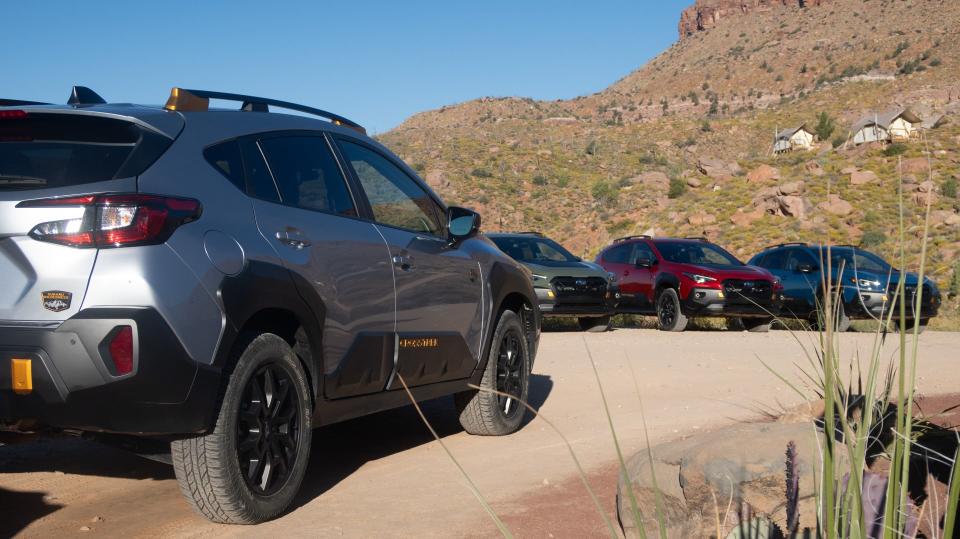
Pretty much the only thing that annoyed me about this car is the fact that it has no onboard navigation system. You can easily skirt this by just running a maps app off your phone via Android Auto or Apple CarPlay though, so it’s really only a problem if you’re going into the off-grid hinterlands and forget to download maps ahead of time.
There are millions of compact crossovers roaming the roads these days but the most direct competitor to the Crosstrek Wilderness is the Jeep Renegade Trailhawk. That thing’s similarly sized and designated, and honestly if you put both vehicles on the same tires they’re probably be able to do all the same terrain. I would expect the Subaru to age a little more gracefully though, based on observed build quality.
Crossover Caution
My buddy Wes Siler, outdoor expert, car writer, and I think I’ve heard him say “dog camping journalist,” is not a fan of cars in this category. He contends that crossovers are the worst of both worlds: “Too tall for good road manners, but not tall enough to actually go off-road.”
In the case of many cars, he’s not wrong. And there’s definitely truth in the idea that vehicles like the Wilderness and Trailhawk can enable hapless people to primarily get stranded further from town than they would have in a base model. However, I do think the Crosstrek Wilderness has a viable balance of good on-road behavior with meaningful off-road capability, especially at this price point.





That said, Siler’s blog made me realize I need to be clear in describing the best way to use something like the Crosstrek Wilderness. Think of it as a car that can go over rough stuff more comfortably and reliably than a normal car, not a car that can suddenly do monster truck stunts because it has an emblem that says “Wilderness.”
But at the same time, you don’t need to feel like you need the forest icon and 0.6-inch lift to take your vehicle on a little adventure. Just educate yourself on driving techniques, and vehicle preparation, and understand your car’s limits before you really try and venture out of cell phone range.
The Early Verdict
Is the 2024 Subaru Crosstrek Wilderness worth it? Most of you probably found this review by asking Google that, so I’ll answer as completely as I can, but the short answer is yes.

You couldn’t really replicate this for less money with aftermarket parts, so there’s value there. And it’s competitively spec’d and priced in the current car market.
In a less empirical sense, I think the enthusiast value of this car is not insignificant. It’s unique—there are not that many small and somewhat efficient cars with earnest off-road pretenses. It’s also one of the coolest-looking practical cars at this price point. The Crosstrek Wilderness is not so superior to a standard Crosstrek that it will boldly go where no other Crosstrek can go, but it will carry you over lumpy terrain with much more comfort and peace of mind thanks to its setup. The Crosstrek Wilderness’ boosted stats will help you enjoy longer adventures—the decorative touches just help you feel cooler. But both make car travel more fun.
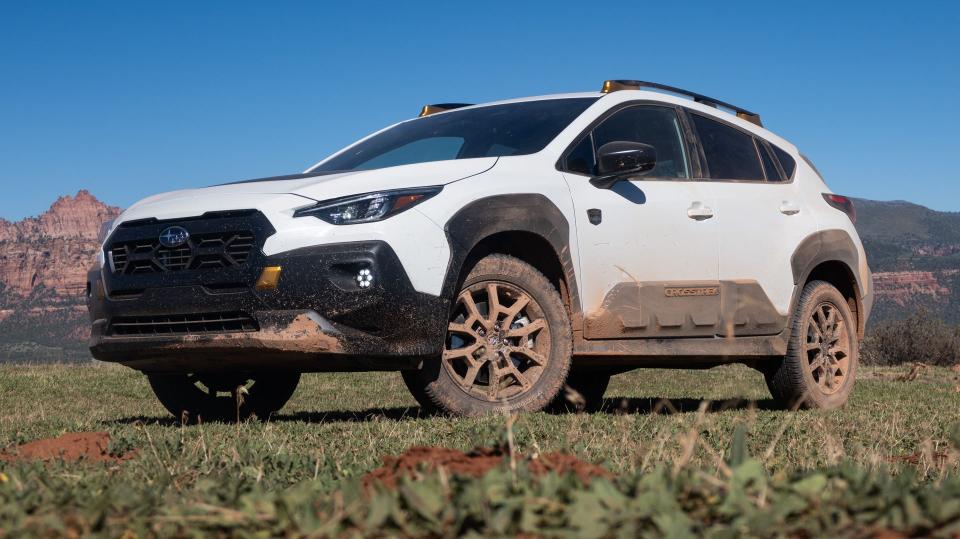
Crosstrek Wilderness Image Gallery
We had a few more pictures of this car roaming around southern Utah that I thought folks might appreciate.












Correction, Oct. 3: Model year 2024 is the beginning of the Crosstrek's third generation, not the second as was previously written. Apologies for the error.

 Yahoo Autos
Yahoo Autos 